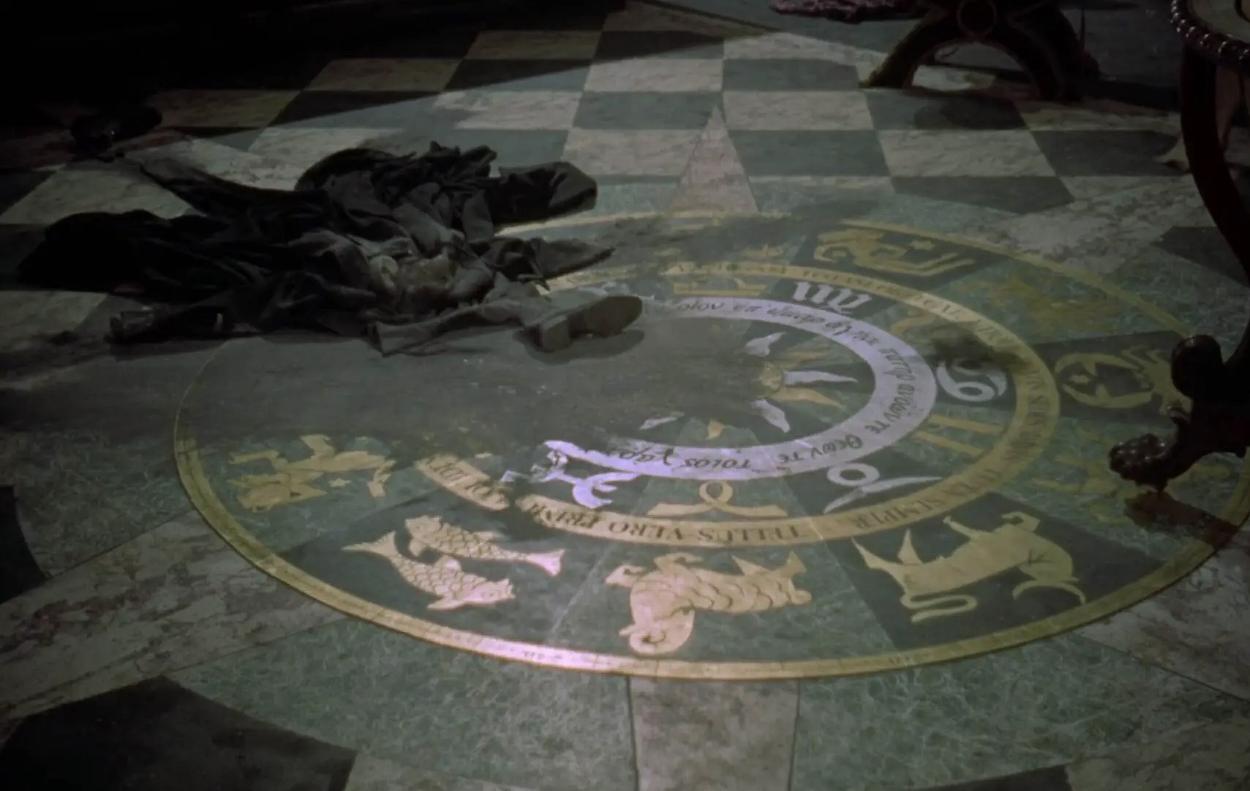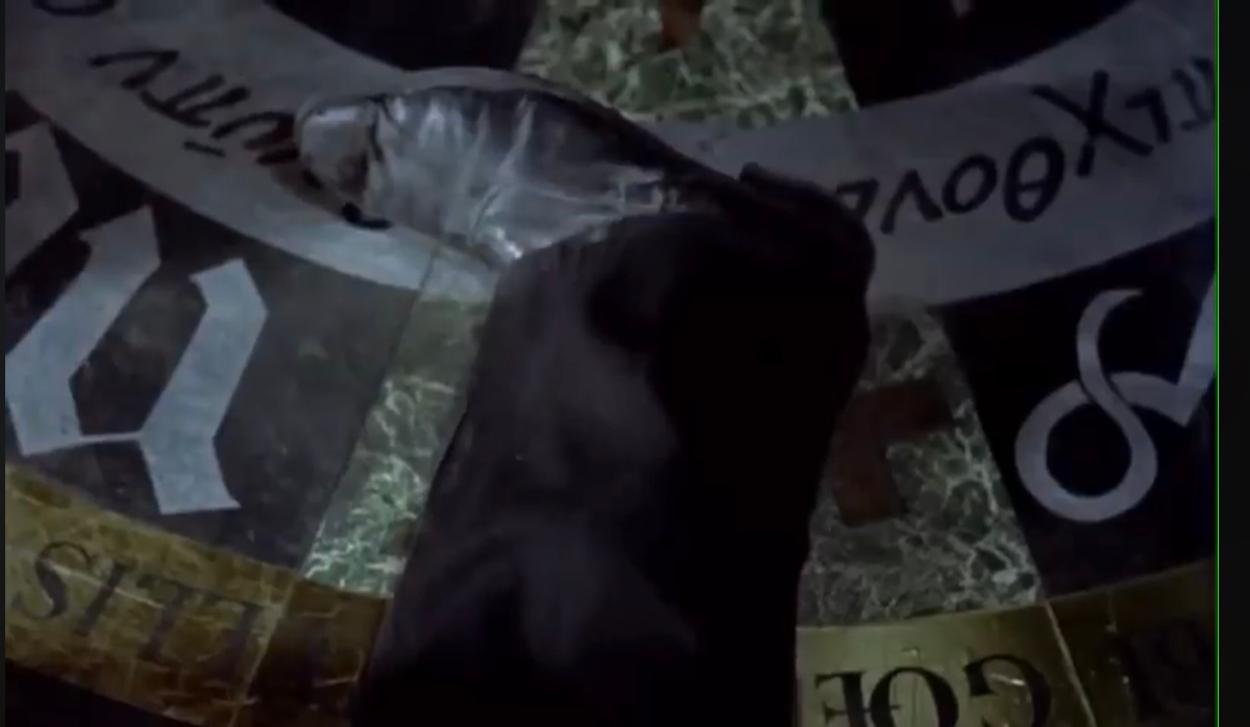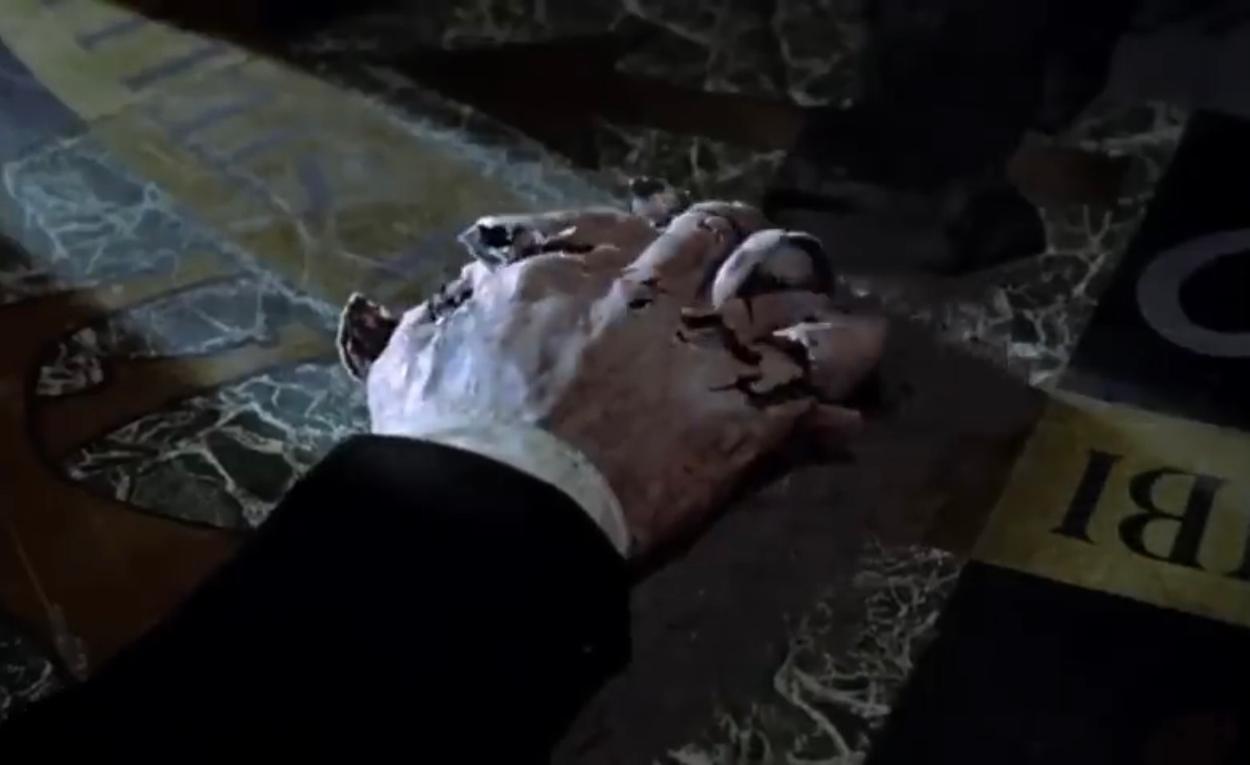Hammer's 'Dracula' (1958) and the Occult Doctrine of Reintegration
In the 1958 Hammer Horror classic 'Dracula' starring Christopher Lee and Peter Cushing, there is a scene where Van Helsing finally defeats Dracula in his crypt. Dracula is transfixed by the shape of a cross while the sunlight consumes him to dust.

The action culminates on an astrological chart (pictured), which was created specifically for the movie at Bray Studios, England, where the interior scenes were filmed (as they had been with all Hammer films since 1951). The floor plan featured Latin and Greek texts in inner and outer circles. The Greek in the outer circle was taken from Homer's Odyssey and read: "For the spirit of men upon the earth is such as the day the Father of gods and men brings upon them." The Latin in the inner circle is a quote from Bartholomew the Englishman (c. 1203–1272), and read: "And Earth first bore starry Heaven, equal to herself, to cover her on every side, and to be an ever-sure abiding-place for the blessed gods."
 In the Odyssey, Arnaeus (or Irus) is an immoral character paid to run errands for the suitors of Odysseus's wife, Penelope. When Odysseus returns to Ithaca in disguise to spy on Penelope, Arnaeus, feeling threatened, challenges him to a duel. With the help of Athena (the goddess of wisdom and victory), Odysseus gains the strength to break Arnaeus's jaw with the first punch. Arnaeus is then thrown out with a command to stop his mischief. The full text of the passage in the Odyssey is, "For he thinks that he will never suffer evil in time to come, so long as the gods give him prosperity and his knees are quick; but then again the blessed gods decree him sorrow, this too he bears in sore despite a steadfast heart; for the spirit of men upon the earth is even such as the day which the Father of gods and men brings upon them." The quotation is therefore concerned with the theme of good triumphing over evil - and the appearance of the latter as strong - whereas, in reality, evil is weak compared to the power of God.
In the Odyssey, Arnaeus (or Irus) is an immoral character paid to run errands for the suitors of Odysseus's wife, Penelope. When Odysseus returns to Ithaca in disguise to spy on Penelope, Arnaeus, feeling threatened, challenges him to a duel. With the help of Athena (the goddess of wisdom and victory), Odysseus gains the strength to break Arnaeus's jaw with the first punch. Arnaeus is then thrown out with a command to stop his mischief. The full text of the passage in the Odyssey is, "For he thinks that he will never suffer evil in time to come, so long as the gods give him prosperity and his knees are quick; but then again the blessed gods decree him sorrow, this too he bears in sore despite a steadfast heart; for the spirit of men upon the earth is even such as the day which the Father of gods and men brings upon them." The quotation is therefore concerned with the theme of good triumphing over evil - and the appearance of the latter as strong - whereas, in reality, evil is weak compared to the power of God.
The Latin quote is from Bartholomew's metaphysical work 'De Proprietatibus Rerum' ('On the Properties of Things'). In it, he described creation in a top-down continuum, starting with God and descending from him to the angels, fallen demons, the celestial spheres, and Earth. He also discussed the genesis of time and the classical elements (fire, air, water, Earth, etc.).

In the movie, both the inner and outer quotations in the diagram focus on appearance versus reality, and the influence of spirit on physical matter. Bartholomew describes time and motion, drawing on Bede's explanation of how the Earth is affected by the motions and forces of the planets on the classical elements. Time is depicted as a force designed by God to govern nature. It is not only linear (in the sense of running continuously from past to present) but streams from the heavens down to Earth in the form of a cross, vertically and linearly. This places ideas of immortality, regeneration, and the age-old struggle of good and evil into a fully cosmological context.

The diagram was created for the film set, showcasing that 'someone' at Hammer had a solid understanding of occult symbology. Bernard Robinson (1912-1970) was the designer for many of Hammer's best movies and a talented painter. He joined Hammer in 1956. One of Robinson's favourite Hammer films was 1958's masterpiece, 'Dracula', which he described as "a contrapuntal thing of horrible things in beautiful places." However, the prolific author of occult novels, Dennis Wheatley (1897-1977) (pictured), is also a potential candidate for the floor plan. Wheatley had many friends in the British film industry, notably Christopher Lee and Hammer's screenwriter, Jimmy Sangster (1927-2011). Wheatley was present during much of the production of 'Dracula', and it is possible (although yet to be established) that the astrological diagram owes its origin to Wheatley as an unofficial advisor.
Returning to the esoteric subject matter, it is not coincidental that Dracula, the Prince of Evil and a vampire, is destroyed on the astrological wheel. As I have written previously ('Treatise on the Reintegration of Beings'), the Rosicrucian-mystical perception of blood as the medium which "connects" spirit to the physical body is a very ancient concept indeed. The quotations from Homer and Bartholomew are essentially reminding us that the Divine Mind of God - and all it commands - can shield humanity from the insinuations of evil in the world. This is because the soul was understood to be connected to the life force or elan vital in blood, and the release of the immortal spirit in man became the target of both the good and evil intelligences alike. This, of course, is the true significance behind the Old Testament story of the Binding of Isaac, whose life was spared from the sacrificial knife of Abraham by God sending a ram to take his place. In ancient times, animal sacrifice was understood to be a means of releasing the spirit concealed within the life force in the blood, it was seen as a purificatory act, a mystical cleansing of the base, primal desires which block the spirit from connecting with the purity of God. The kohen priests of the Jerusalem Temple believed they could attain greater purity and proximity to the Divine by immolating the blood sacrifice. The very opposite was achieved by ingesting the blood itself, as practised by many ancient cults (such as that of Cybele and Attis during the 'Day of Blood'), and which was viewed by the kohens as an act of defilement, since the purpose of blood sacrifice was to elevate the soul by transforming the butchered parts of the victim by fire. The body was destroyed by fire and became vaporous. Air was recognised as the element of spirit freed from its physical prison.
essentially reminding us that the Divine Mind of God - and all it commands - can shield humanity from the insinuations of evil in the world. This is because the soul was understood to be connected to the life force or elan vital in blood, and the release of the immortal spirit in man became the target of both the good and evil intelligences alike. This, of course, is the true significance behind the Old Testament story of the Binding of Isaac, whose life was spared from the sacrificial knife of Abraham by God sending a ram to take his place. In ancient times, animal sacrifice was understood to be a means of releasing the spirit concealed within the life force in the blood, it was seen as a purificatory act, a mystical cleansing of the base, primal desires which block the spirit from connecting with the purity of God. The kohen priests of the Jerusalem Temple believed they could attain greater purity and proximity to the Divine by immolating the blood sacrifice. The very opposite was achieved by ingesting the blood itself, as practised by many ancient cults (such as that of Cybele and Attis during the 'Day of Blood'), and which was viewed by the kohens as an act of defilement, since the purpose of blood sacrifice was to elevate the soul by transforming the butchered parts of the victim by fire. The body was destroyed by fire and became vaporous. Air was recognised as the element of spirit freed from its physical prison.
 We can, therefore, see why blood is desired by the mythological vampire, because it forms the junction between the animal and spiritual parts of man; being that which exists between the corrupt physical body and pure spiritual forms. The vampire seeks to ingest that immortal spirit within himself and therefore become master of it. In doing so, he will always cast a veil over the light of spirit in his victim and forever obfuscate the truth and reality of goodness and of the Creator. it will also be observed that Dracula's death in the film involves not a transmutation into air (elemental spirit) but into the dust of the Earth instead; thereby expressing his non-reintegration and devolution back into the base prison of materiality. Indeed, a globe representing the physical Earth is placed directly next to the astrological chart representing the celestial spheres. This is clearly a well-conceived point being made by the film makers.
We can, therefore, see why blood is desired by the mythological vampire, because it forms the junction between the animal and spiritual parts of man; being that which exists between the corrupt physical body and pure spiritual forms. The vampire seeks to ingest that immortal spirit within himself and therefore become master of it. In doing so, he will always cast a veil over the light of spirit in his victim and forever obfuscate the truth and reality of goodness and of the Creator. it will also be observed that Dracula's death in the film involves not a transmutation into air (elemental spirit) but into the dust of the Earth instead; thereby expressing his non-reintegration and devolution back into the base prison of materiality. Indeed, a globe representing the physical Earth is placed directly next to the astrological chart representing the celestial spheres. This is clearly a well-conceived point being made by the film makers.

It is no coincidence that in the movie, Van Helsing uses two candlesticks - symbolic luminaries - to make the shape of a cross to keep Dracula at bay while the beam of light from the window consumes his body and returns it to the dust of the earth. Dracula fears the cross; not from superstition, but because it represents a power greater than his own which envelops the darkness within from all four cardinal directions. The cardinal points are the four main compass directions of north, south, east, and west. Relative to north, the directions east, south, and west are at 90 degree intervals in a clockwise direction. The Sun rising in the east through the window suggests that Dracula is immolated in the north but with his head towards the south (which latter point is commonly associated with the locale of evil in the occult).
We can now see the true meaning of the quote from Bartholomew, "And Earth first bore starry Heaven, equal to herself, to cover her on every side, and to be an ever-sure abiding-place for the blessed gods."


Article (c) 2024 M.R. Osborne






